calsfoundation@cals.org
Marmaduke (Greene County)
| Latitude and Longitude: | 36°11’13″N 090°22’59″W |
| Elevation: | 279 feet |
| Area: | 1.40 square miles (2020 Census) |
| Population: | 1,212 (2020 Census) |
| Incorporation Date: | August 2, 1909 |
Historical Population as per the U.S. Census:
|
1810 |
1820 |
1830 |
1840 |
1850 |
1860 |
1870 |
1880 |
1890 |
1900 |
|
– |
– |
– |
– |
– |
– |
– |
– |
– |
– |
|
1910 |
1920 |
1930 |
1940 |
1950 |
1960 |
1970 |
1980 |
1990 |
2000 |
|
780 |
861 |
894 |
677 |
643 |
657 |
821 |
1,168 |
1,164 |
1,158 |
|
2010 |
2020 |
|
|
|
|
|
|
|
|
|
1,111 |
1,212 |
Marmaduke played a big role in the history of Greene County. A booming lumber, cotton, and railroad town in its early heyday, Marmaduke is located twelve miles northeast of Paragould, the county seat, in the northeast corner of Greene County.
Civil War through Reconstruction
One theory holds that the town was named for Confederate General John Sappington Marmaduke. Marmaduke was said to have established a camp for his soldiers near the site of the present town. After crossing the St. Francis River at Chalk Bluff (Clay County) in 1863, Marmaduke and his troops marched south into Greene County to find a place to camp. They occupied the site for several weeks, and the general used it as his headquarters while the troops tried to capture William Quantrill’s Raiders, a ruthless band of roughnecks that preyed on residents along the Arkansas, Kansas, and Missouri borders. Another possible factor in the naming of the town was that towns springing up along railroads were often named after people associated with the railroad companies. John S. Marmaduke had served on the Missouri Railway Commission from 1875 until 1880 and no doubt would have served as a resource of information in developing the new line, with regard to the conditions of the terrain and accessibility after various Civil War engagements.
Post-Reconstruction through the Gilded Age
The Cotton Belt Railroad Company used the roads cut by Marmaduke and his men, as well as the roads used by the lumber mills to haul timber, to lay tracks for the new railroad. The railroad company decided to build a narrow gauge line instead of the standard gauge. The narrow gauge was more suitable for handling the bulk of cotton that was transported in large quantities over the railroad. The county had few settlements between Jonesboro (Craighead County) and the St. Francis River, so it was determined to place the depot stations at towns that were already cleared settlements along the route. The stations were placed at Marmaduke and Paragould by the Cotton Belt Railroad. The tracks ran along the rivers and through the fertile ground where cotton was plentiful. The town was first laid out by the railroad company in 1882 and had a population of 200 people at the time.
Early Twentieth Century
In the early 1900s, there were three Cotton Gins in Marmaduke, providing work and trade to the town. The cotton industry in Arkansas had its share of hardship in the early 1900s in Greene County. Nightriders, a group of ruthless, masked gunmen, went from town to town on horseback, burning wagons of cotton and intimidating plantation farmers into not marketing their cotton unless they sold it for fifteen cents a pound through the Farmers Union Warehouse. The first real outbreak was in 1908, when newspapers reported nightrider attacks in Marmaduke, Walcott (Greene County), Lake City (Craighead County), Jonesboro, and other small cotton farming communities. The group posted notices on the gins instructing owners not to gin any more cotton “until further notice” or “suffer the consequences.” Some farmers received threatening letters demanding that they leave the state. The following year, nightriders caused even more destruction as they terrorized farmers and gin owners. On September 27, 1908, the Farmers District Union of Marmaduke passed a resolution requesting merchants and other businesses to buy no cotton. Marmaduke made the first step, and other towns in the county were soon to follow. The state of Arkansas eventually brought in the military to capture the nightriders, but in Marmaduke and surrounding communities, many farmers fled in fear, leaving behind their farms.
On August 2, 1909, Mayor E. P. Holt signed an ordinance making Marmaduke an incorporated town.
The cotton farming industry was hit hard during the Great Depression. The banks closed, and the town of Marmaduke lost businesses and, later, citizens when the jobs ran out. Many moved north to look for work and a new way of life.
Industry
The first sawmill noted was built by C. P. Huckabay in 1856 . Huckabay was the first sawmill operator to build a narrow gauge railway into the woods to transport the logs to the sawmill. In 1905, the Vaile Doldson Company took over Huckabay’s Mill. Other sawmills—such as Lalley Mills, J. T. Turner, and Lesser & Goldman—also located in Marmaduke.
In 1911, the citizens of Marmaduke raised the $800 necessary to secure a slack-barrel factory for the town of Marmaduke, which brought more jobs and settlers to the fast rising town. In 1912, John Wiley Cupples bought a sawmill at Piggott (Clay County) and moved it to Marmaduke. The sawmill was located at the curve south of Marmaduke. The land was covered in timber, and there were no paved roads to Paragould then. The timber industry brought new businesses during the early 1900s, including hotels and boarding houses that opened to help accommodate travelers visiting the town. The “boom days” of the timber industry brought new people to Marmaduke each day.
Education
The earliest school building in town was a one-room school located where Emma Moore lived; she was the first person recorded as being born at Marmaduke (January 31, 1876), years before there were plans for the town. School was in session only four or five months a year. The one-room school eventually was divided into two rooms, and there were two teachers.
Teachers’ Normal School, located at Marmaduke, played a big role in the early school system. The school for teachers was conducted during students’ vacation, beginning in the 1890s. Teachers came from all over Arkansas to study for their state teaching licenses. At the time, they had to take “long and rugged” examinations in fourteen subjects. Also, all teachers in the county were required to attend an annual institute in Paragould to stay informed on the latest educational methods. Records show that 126 teachers attended the institute in Paragould in 1907. When the Normal School was in session, the town of Marmaduke became alive with social life. The visiting teachers would board at the boarding houses in Marmaduke.
World War II through the Modern Era
After World War II, farmland became more valuable than timber as the method of clearing land changed to bulldozers, leaving no young timber. Timber became scarce and more expensive, and sawmills became a thing of the past.
Marmaduke today is home to manufacturers ARI, which makes railway tankers and employs 100 to 150 people, and Anchor, which makes plastic products and employs about 100 people; in addition, a Delta co-op employs about an additional ten to twenty people during the harvest season. A lot of the local citizens work at the factories in Marmaduke or other branches of the factories at Paragould.
Most of the surrounding land is used for farming. Soybeans, rice, corn, and cotton are the main crops. The railroad still plays a big role in Marmaduke, delivering supplies to factories and exporting manufactured products.
During the tornado outbreak of March 1, 1997, one tornado passed through the center of Marmaduke and killed a person. On April 2, 2006, a tornado swept through town and destroyed approximately 300 homes, resulting in the town being declared a disaster area.
For additional information:
Fielder, Mona L. “History of Marmaduke, Arkansas, Recreated.” Greene County Historical and Genealogical Quarterly 12, no. 4 (1999): 132–135.
Goodspeed’s History of Greene County, Arkansas. Chicago: Goodspeed Publishing Co., 1889.
Greene County Index. http://www.usgennet.org/usa/ar/county/greene/ (accessed July 20, 2022).
Hale, Donna Kay. The First 50 Years of Marmaduke, Arkansas. N.p.: 2020.
———. Marmaduke Greyhounds: Over 100 Years in the Making. N.p.: 2020.
Marmaduke, Arkansas: 1950 to Present Time. http://marmadukehounds.blogspot.com/ (accessed November 25, 2024).
Mueller, Myrl Rhine. A History of Greene County, Arkansas. Little Rock: Parkhurst Book Design, 1974.
Mueller, M. R., ed. “History of Marmaduke, Arkansas.” Greene County Historical and Genealogical Quarterly 1 (Summer 1965): 5–17.
Tina Easley
Marmaduke, Arkansas
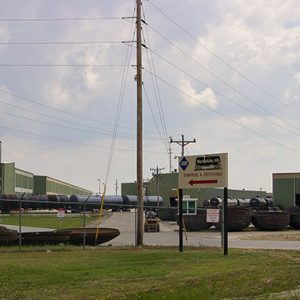 American Railcar Industries
American Railcar Industries 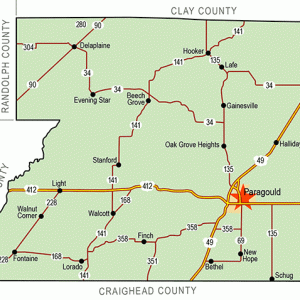 Greene County Map
Greene County Map 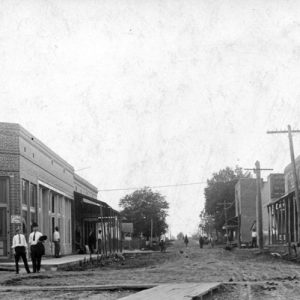 Marmaduke Street Scene
Marmaduke Street Scene 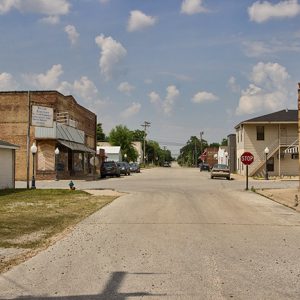 Marmaduke Street Scene
Marmaduke Street Scene  John Marmaduke
John Marmaduke 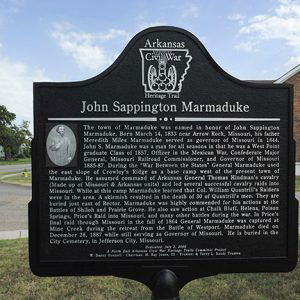 John Sappington Marmaduke Marker
John Sappington Marmaduke Marker 



Comments
No comments on this entry yet.